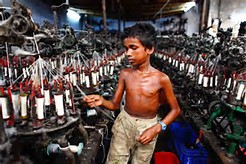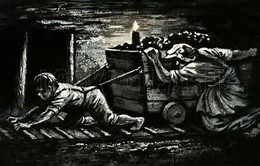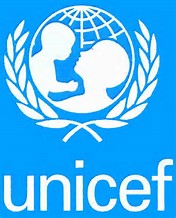Child Labour Then and Now
Bangladesh 2017
By Adam Weber
Bangladesh
Bangladesh is a small country boarded by India on all on all sides with the Indian ocean to the south of it. It has a popula tion of 161 million people as of 2015 and around 3.2 million children involved in child labour. Bangladesh is mostly made up of flatlands with some marshes and sub tropical rain forests, and it boarders the Himalayan mountains. it is very close to sea level, and scientists speculate that if the ocean were to rise 1 meter, 10% of Bangladesh would flood. its biggest industry is agriculture, with them being some of the worlds top producers of Rice, Potatoes, Tropical Fruits, Jute and farmed fish. Its second biggest industry (and the one I’m going to focus on) is the textile industry.
tion of 161 million people as of 2015 and around 3.2 million children involved in child labour. Bangladesh is mostly made up of flatlands with some marshes and sub tropical rain forests, and it boarders the Himalayan mountains. it is very close to sea level, and scientists speculate that if the ocean were to rise 1 meter, 10% of Bangladesh would flood. its biggest industry is agriculture, with them being some of the worlds top producers of Rice, Potatoes, Tropical Fruits, Jute and farmed fish. Its second biggest industry (and the one I’m going to focus on) is the textile industry.
Child Labour in Bangladesh
Child Labour is quite common in Bangladesh, and is a part of daily life. you can see many children working hard and long to make a living for themselves. Bangladesh is very much a 3rd world country and many children and family’s are very poor and need to send their children to work to help pay for the cost of living. Child Labour is widely accepted here, and there are many different kinds of child labour that happens. child here work as: working roadside stalls, weaving between cars to sell goods to motorists, and the biggest industry of all, working in the textile industry. child labour makes up about 12% of the population of children ages 5-14, and only 25% of these kids can attend school. There are often as young as 9, even though the minimum age to work is 14. The  main reason for child labour is poverty, not often are children given away as payment to cover parents debt. Children in Bangladesh suffer from a serious problem because of child labour. A lack of Education and extremely unsafe working conditions that can be subject to fires and collapses in the factory’s that they work in and being easily injured by the machines due to lack of safety devices. they may also be subject to beatings for not working fast enough or being late. they are forced to work much overtime despite lack of pay and the average time they work is about 28 hours a week. For how much? around $3.30 U.S. Great pay right? without this tiny about of money they would starve to death, but many movements are starting to crack down on child labour. Such as UNICEF, my favorite of the movements.
main reason for child labour is poverty, not often are children given away as payment to cover parents debt. Children in Bangladesh suffer from a serious problem because of child labour. A lack of Education and extremely unsafe working conditions that can be subject to fires and collapses in the factory’s that they work in and being easily injured by the machines due to lack of safety devices. they may also be subject to beatings for not working fast enough or being late. they are forced to work much overtime despite lack of pay and the average time they work is about 28 hours a week. For how much? around $3.30 U.S. Great pay right? without this tiny about of money they would starve to death, but many movements are starting to crack down on child labour. Such as UNICEF, my favorite of the movements.
Child Labour is not the same thing as working children by this definition by UNICEF. “Child labour is work that exceeds a minimum number of hours, depending on the age of a child and on the type of work. Such work is considered harmful to the child and should therefore be eliminated. Ages 5-11: At least one hour of economic work or 28 hours of domestic work per week. Ages 12-14: At least 14 hours of economic work or 28 hours of domestic work per week. Ages 15-17: At least 43 hours of economic or domestic work per week.” this is how they plan on finding a median, not having the children banned from working, but rather putting strict rules on how much a child can work and have appropriate work conditions. With these movements, child labour is becoming less used as they have managed to secure safe, fair working environments for many children, but it is still not enough.
Child labour During the Industrial Revolution:
During the industrial revolution, many children where put to work in many forms of child labour including the textile factories, as personal servants and in the coal mines.
In the textile factories, small children were used as “scavengers” or ‘piecers’. It was these small agile children’s jobs to pick up all the little fluffs of cotton and strings that fell under the machines, however this was done while the machines where still running! Working as a scavenger in these big textile factory’s meant that the microscop ic fibres in the air would get into your lungs and cause breathing problems and they where not treated very well. with the long hours of dawn till dusk, children could easily become deaf from the noise of the machines. another job children had in these factories was repairing the machines, the reasons for this was because children had small arms that could fit into the small spaces to replace the broken part, and if a little hand got caught in it because the machine suddenly broke or turned on, it could chop of fingers and destroy the hand entirely. When this happened the owners didn’t care about the deformed child. they just replaced you with no second thoughts with someone who had 2 good hands.
ic fibres in the air would get into your lungs and cause breathing problems and they where not treated very well. with the long hours of dawn till dusk, children could easily become deaf from the noise of the machines. another job children had in these factories was repairing the machines, the reasons for this was because children had small arms that could fit into the small spaces to replace the broken part, and if a little hand got caught in it because the machine suddenly broke or turned on, it could chop of fingers and destroy the hand entirely. When this happened the owners didn’t care about the deformed child. they just replaced you with no second thoughts with someone who had 2 good hands.
If you worked in the mine shafts you were usually quite small as the mines had very small shafts and the days where made up of pulling and pushing large coal carts everyday, all day long. The labours (children and adults) who worked the mine shafts would work from sunrise to sunset everyday, and this caused the children working there to develop black lung. this was developed from inhaling the coal dust for so long, and the workers often became
Generally child labour was an awful thing for any child to be a part of, and usually the jobs where cruel and unsafe to work in. As I said above factory owners didn’t really care about the kids they had working for them. the reason they even hired kids is because they could fit into small  spaces and where automatically more obedient then adults They paid them as little as possible to make more profit for themselves(often under 1 U.S. dollar a day), and where sometimes forced to accept part of their pay in food instead of money. in the textile industry, the industry I’m focusing on, Britain had a law that prevented children from working over 12 hours a day, but there where no inspectors to enforce the law so the owners made them work over the 12 hour limit without a care in the world.
spaces and where automatically more obedient then adults They paid them as little as possible to make more profit for themselves(often under 1 U.S. dollar a day), and where sometimes forced to accept part of their pay in food instead of money. in the textile industry, the industry I’m focusing on, Britain had a law that prevented children from working over 12 hours a day, but there where no inspectors to enforce the law so the owners made them work over the 12 hour limit without a care in the world.
however, they couldn’t just get rid of child labour outright, for the reasons the children where working was because they where poor. they had entire family’s of what could be 11 people living in 1 room, and there is no way a poor mother and father could provide for them, so they sent their kids out to work because otherwise they would almost certainly starve (without turning to crime). So banning it outright would not work as the kids would have no way to sustain themselves without the bad paying job.
Comparison: Then and Now
unfortunately, there are many more similarities between child labour during the industrial revolution and now in Bangladesh. Both in the industrial revolution and now to workers work because of poverty and have extremely harsh conditions that could maim or kill the worker, they where beaten for coming in late, they got paid tiny amounts of money, and they both have laws that where never followed due to lack of inspectors. another similarity was they both where trying to provide for their families. some of the differences however, where that the minimum age to work in factories during the industrial revolution was 9, and in Bangladesh its 14. The people of Bangladesh are starting to see some changes due to being cut off by companies not wanting to be associated with child labour, and in Bangladesh the children aren’t cleaning up or repairing the factories or machines, they’re the ones doing the weaving.
Movements to stop child labor
(in Bangladesh and back In the industrial revolution)
There are many m ovements to stop child labour on a global scale. Organisations such as UNICEF and Free the children have been working on saving children from the awful existence of being child labourers. In the year 1833 there was an against child labour act during the industrial revolution that helped the child labourers and gave them better working conditions, but it didn’t have much effect as these rules were not followed or enforced. In some people’s cases this was a good thing, however for other people, this made survival much harder because their families didn’t have the extra salary coming in.
ovements to stop child labour on a global scale. Organisations such as UNICEF and Free the children have been working on saving children from the awful existence of being child labourers. In the year 1833 there was an against child labour act during the industrial revolution that helped the child labourers and gave them better working conditions, but it didn’t have much effect as these rules were not followed or enforced. In some people’s cases this was a good thing, however for other people, this made survival much harder because their families didn’t have the extra salary coming in.
Citations
“Bangladesh: Major ILO programme aims to make garment industry safer.” International labour organization. N.p., n.d. Web. <http://www.ilo.org/dhaka/Whatwedo/Projects/bangladesh-rmg-programme/lang–en/index.htm>.
“Bangladesh.” Wikipedia. N.p., n.d. Web. 6 Apr. 2017. <https://en.wikipedia.org/wiki/Bangladesh>.
UNICF. “Child Labour in Bangladesh.” UNICF, n.d. Web. June 2010. <https://www.unicef.org/bangladesh/Child_labour.pdf>.
Cranny, Michael. Crossroads: Meeting of Nations. Toronto: Pearson Education, 1998. Print.
“Bangladesh Garment industry still exploiting Child Labour for UK Products.” The guardian. N.p., n.d. Web. <https://www.theguardian.com/world/2014/feb/06/bangladesh-garment-factories-child-labour-uk>.
and prior knowledge from discussions
